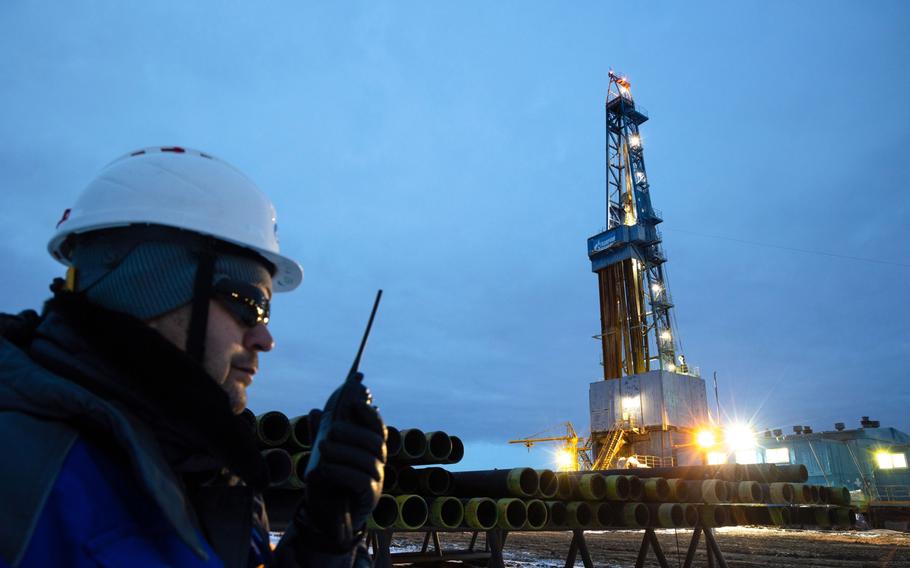
Lights illuminate a gas drilling rig on the Gazprom Chayandinskoye oil, gas and condensate field, a resource base for the Power of Siberia gas pipeline, in the Lensk district of the Sakha Republic, Russia, on Oct. 13, 2021. (Andrey Rudakov/Bloomberg)
European gas prices surged as Moscow tightened its squeeze on crucial gas flows to the continent, forcing consumer nations to confront the prospect of keeping their economies running without Russian gas.
Benchmark futures increased as much as 24%, adding to a 46% rise already this week. The cuts are rippling through Europe with companies including Eni SpA, Engie SA and Uniper SE saying they’re getting less supply. Germany has called the reductions through the Nord Stream pipeline “politically motivated” and aimed at unsettling markets, challenging Gazprom PJSC’s statement that the halt was due to technical issues.
Europe has for months feared Russian supply cuts in retaliation for sanctions aimed at Moscow for its invasion of Ukraine. The latest crisis could hit key industries from chemicals companies to steelmakers, a body blow for the region that’s already struggling with surging inflation and meager growth.
Germany’s top energy regulator urged consumers and industry to scale back consumption to help fill storage sites ahead of the next heating season. Gas rationing is becoming a real prospect.
Moscow’s move comes as German Chancellor Olaf Scholz, French President Emmanuel Macron and Italian Prime Minister Mario Draghi arrived in Kyiv Thursday for talks with President Volodymyr Zelensky in the highest-profile visit to the country since Russia invaded at the end of February.
The Kremlin said on Thursday the cuts were “not deliberate.”
Russia has been slowly tightening its grip on European energy markets, halting gas shipments to Poland, Bulgaria and Finland due to a dispute over President Vladimir Putin’s demand that the fuel should be paid for in rubles. Now even the countries that found workarounds to keep Russian gas flowing are getting cut out.
Berlin has already triggered the first stage of a three-step emergency plan to ensure security of supply, and may be forced to go further if the cuts deepen. The country, however, has said it can for now secure alternate supplies.
Utility Uniper said it had received 25% less than contracted from Russia, while Austria’s OMV AG and France’s Engie also got lower volumes. Italy’s Eni said Gazprom was providing only 65% of the requested amount on Thursday.
The supply cut announced on Wednesday follows reductions the previous day after Gazprom cited issues with repairs of turbines produced by Siemens. Western sanctions on Russia have left equipment key for the functioning of the Nord Stream gas pipeline stuck abroad.
Supply through the link is expected to drop to just under 65 million cubic meters a day on Thursday, according to nominations data. That brings the total cut through Nord Stream to about 60%.
Separately, a fire broke out at Gazprom’s second-biggest gas-producing fields in West Siberia on Wednesday evening. The company’s regional unit, however, said the blaze was extinguished and output hasn’t been affected.
The latest crisis between Russia and Europe adds to a supply crunch already created by an outage in the US. A major liquefied natural gas export facility in Texas — a vital source of supply for Europe — will remain shut for longer than initially anticipated following a fire last week.
“This has the potential to provide strong bullish pressure to global LNG markets, with Europe in particular exposed to the upside,” consultant Inspired Energy said in a note. The shut Freeport plant has sent 70% of its cargoes to Europe in recent months.
The disruptions come just as a bout of intense heat that’s gripping Europe drives up gas demand for cooling. The continent may now have to compete more fiercely with Asian buyers to secure spare LNG supply as they rush to replenish storage facilities before demand peaks again in the winter.
Delays in filling inventories could lead to a tough winter, especially if Russian supply at the time continues to be curbed. “Gas prices will continue in the winter to be very high,” Marco Alvera, former chief executive officer of Italian network operator Snam, said at a conference on Thursday.
Dutch front-month gas futures, the European benchmark, were 21% higher at 145.50 euros per megawatt-hour by 3 p.m. in Amsterdam. The UK equivalent gained 20%. German month-ahead power advanced as much as 27%.
Russia’s gas cuts are stoking prices in Asia too. Asian spot LNG on Thursday extended gains to hit the highest levels since early March, according to traders familiar with the price settlement.
Further disruptions to gas or LNG flows could amplify price moves. “If we get another outage like what happened at the Freeport LNG in the U.S. prices could easily jump another 50%,” said Ron Smith, senior oil and gas analyst at BCS Global Markets.